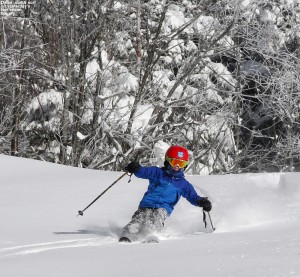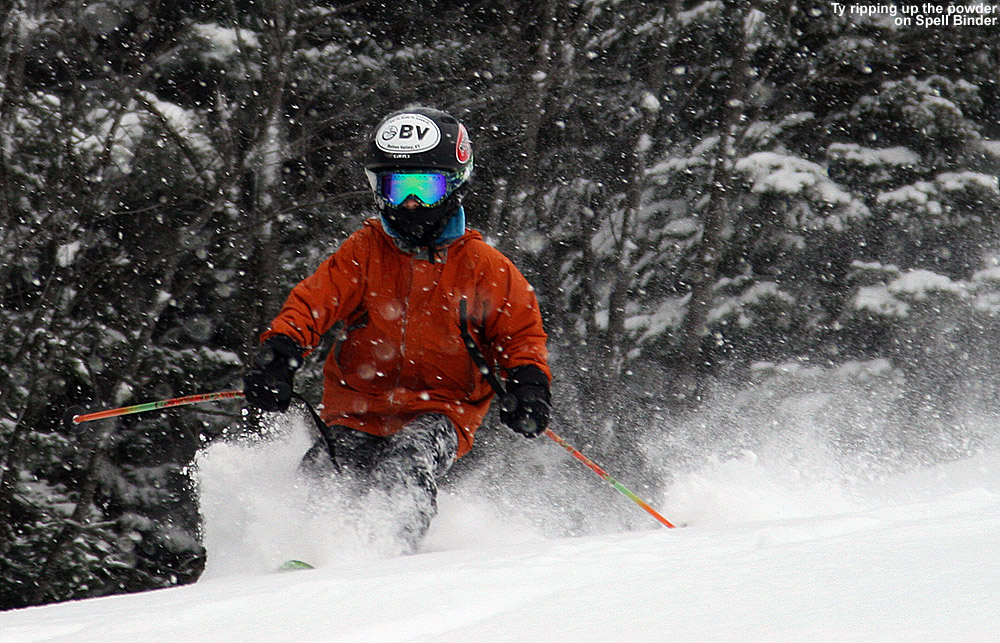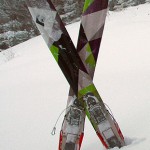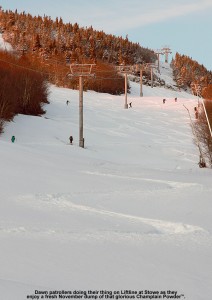
Last night the back end of the storm cycle brought a change to much fluffier, upslope-style snowfall comprised of larger flakes that settled down in the 2-3% H2O range here in the valley. Unless there was excessive wind, the combination of that snow atop the denser, synoptic snow that we received yesterday, was likely to make for some fantastic skiing. With the upslope snow came colder temperatures; morning temperatures at Bolton were around 10 F, so we decided it was a good day to stay off the lifts and earn some turns instead. We contemplated heading out onto the backcountry network at Bolton Valley, but with Timberline lift service still on hold, it was better to take advantage of the terrain there while we still had the chance.
“The skiing was just turn
after turn of bottomless
powdery bliss, so I’ll
just defer to the pictures
and let them talk about it.”
E picked up Ty from his overnight visit at a friend’s house, and it turned out that he was really eager to come home and do some skiing. Dylan was also surprisingly excited to get on his Telemark skis and earn some turns, so we had to ride that wave of enthusiasm. I still had to trim the skins for E’s Black Diamond Elements, but by mid afternoon the skis were all skinned, the rest of the gear was ready, they boys had chilled out enough, and we headed up to Timberline. The snow from the end of the storm had tapered off in the morning, but not before Bolton had picked up another 10 inches of December goodness. It was a bit brisk at the Timberline Base, with temperatures in the lower teens F, and even a bit of wind, but we knew we’d be in good shape once we got on the ascent.

There were just a few cars in the Timberline lot, so it didn’t seem like the resort needed to use it for overflow parking today. The lots had been plowed, but there’s still tons of snow everywhere and we were able to skin right from the car. Ty and E were leading the ascent, and when they inquired with me about which way to go, I just suggested that they follow the most established skin track to make things easy. An ascent of either Twice as Nice or Showtime would work out fine. Twice as Nice wound up being the most travelled option, with one, and at times even two, well established skin tracks up the climber’s left. One had a few dog prints in it, but there were not footprints, post-holes, or even snowshoe tracks. The full-width skins on the AMPerages and Elements were working great, and E and Ty just blazed up the skin track at what felt like breakneck speed. I hung back with Dylan, who was feeling tired, and although I didn’t have any GU to get him going, once I pointed out that he had Grandma’s ginger snap cookies in his pack, and he ate one, he really perked up. Beyond that point he just shot to the top of our ascent and that was that. E and Ty were already waiting for us, camped out of the wind beneath the Timberline Mid Station. We pulled out the hot soup, and hot cocoa, and everyone had their fill while we prepared the gear for the descent.

Since I’d had such a good run on Showtime yesterday, we opted to descend there. Of course now it had yet another round of snow on it – in this case a nice shot of Champlain Powder™ to hopefully hit that skiing powder pinnacle of the right-side-up density gradient. I dropped in off the headwall and found that snow that was just as good as yesterday, but with that little extra bubbly champagne on top to make it even more fun. One exciting aspect of the outing was that the boys actually worked on Telemark turns in deep powder. They haven’t even mastered the on groomed terrain yet, but they were game to work them into their powder skiing, and they actually had a good degree of success. E got yet another chance to test out her Elements on their preferred surface, and she looked quite good on the challenging step and deep conditions of the Showtime Headwall. We had late day sun illuminating our descent at times, or lighting up the tracks with an afternoon orange glow (enhanced all that much more by our amber goggle lenses). The skiing was just turn after turn of bottomless powdery bliss, so I’ll just defer to the pictures and let them talk about it.




























































































































